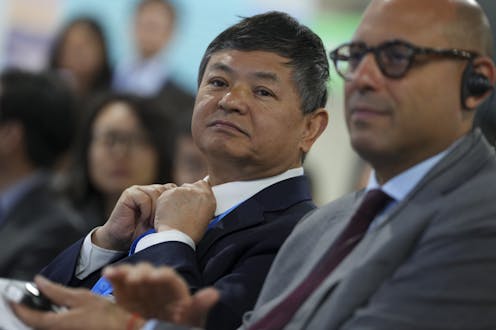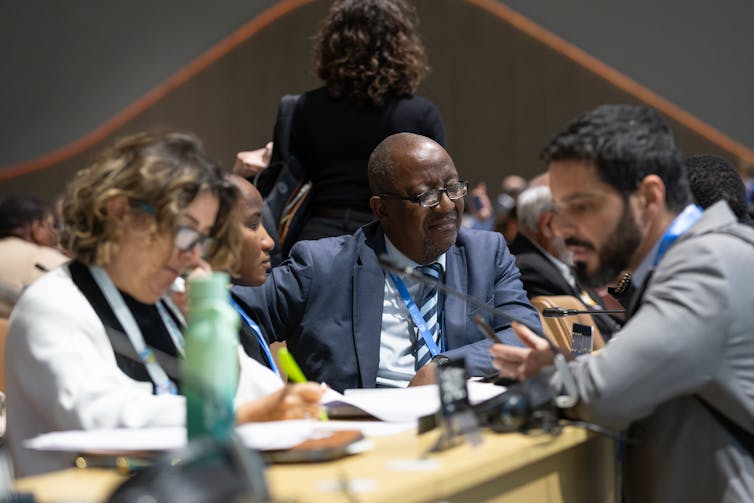
The 2024 U.N. climate talks ended in Baku, Azerbaijan, on Nov. 24 after two weeks of arguments, agreements and side deals involving 106 heads of states and over 50,000 business leaders, activists and government representatives of almost every country.
Few say the conference was a resounding success. But neither was it a failure.
The central task of the conference, known as COP29, was to come up with funding to help developing countries become more resilient to the effects of climate change and to transition to more sustainable economic growth.
The biggest challenge was agreeing on who should pay, and the results say a lot about the shifting international dynamics and offer some insight into China’s role. As a political science professor who has worked on clean tech policy involving Asia, I followed the talks with interest.
Slow global progress
Over three decades of global climate talks, the world’s countries have agreed to cut their emissions, phase out fossil fuels, end inefficient fossil-fuel subsidies and stop deforestation, among many other landmark deals.
They have acknowledged since the Rio Earth Summit in 1992, when they agreed to the U.N. Framework Convention on Climate Change, that greenhouse gas emissions produced by human activities, including the burning of fossil fuels, would harm the climate and ecosystems, and that the governments of the world must work together to solve the crisis.
But progress has been slow.
Greenhouse gas emissions were at record highs in 2024. Governments are still subsidizing fossil fuels, encouraging their use. And the world is failing to keep warming under 1.5 degrees Celsius compared with preindustrial times – a target established under the 2015 Paris Agreement to avoid the worst effects of climate change.
Extreme weather, from lethal heat waves to devastating tropical cyclones and floods, has become more intense as temperatures have risen. And the poorest countries have faced some of the worst damage from climate change, while doing the least cause it.
Money for the poorest countries
Developing countries argue that they need US$1.3 trillion a year in financial support and investment by 2035 from the wealthiest nations – historically the largest greenhouse gas emitters – to adapt to climate change and develop sustainably as they grow.
That matters to countries everywhere because how these fast-growing populations build out energy systems and transportation in the coming decades will affect the future for the entire planet.

At the Baku conference, member nations agreed to triple their existing pledge of $100 billion a year to at least $300 billion a year by 2035 to help developing countries. But that was far short of what economists have estimated those countries will need to develop clean energy economies.
The money can also come from a variety of sources. Developing countries wanted grants, rather than loans that would increase what for many is already crushing debt. Under the new agreement, countries can count funding that comes from private investments and loans from the World Bank and other development banks, as well as public funds.
Groups have proposed raising some of those funds with additional taxes on international shipping and aviation. A U.N. study projects that if levies were set somewhere between $150 and $300 for each ton of carbon pollution, the fund could generate as much as $127 billion per year. Other proposals have included taxing fossil fuels, cryptocurrencies and plastics, which all contribute to climate change, as well as financial transactions and carbon trading.
China’s expanding role
How much of a leadership role China takes in global climate efforts is an important question going forward, particularly with U.S. President-elect Donald Trump expected to throttle back U.S. support for climate policies and international funding.
China is now the world’s largest emitter of greenhouse gases and the second-largest economy.
China also stands to gain as provider of the market majority of green technologies, including solar panels, wind turbines, batteries and electric vehicles.
Whether or not China should be expected to contribute funding at a level comparable to the other major emitters was so hotly contested at COP29 that it almost shut down the entire conference.
Previously, only those countries listed by the U.N. as “developed countries” – a list that doesn’t include China – were expected to provide funds. The COP29 agreement expands that by calling on “all actors to work together to enable the scaling up of financing.”
In the end, a compromise was reached. The final agreement “encourages developing countries to make contributions on a voluntary basis,” excluding China from the heavier expectations placed on richer nations.
Side deals offer signs of progress
In a conference fraught with deep division and threatened with collapse, some bright spots of climate progress emerged from the side events.
In one declaration, 25 nations plus the European Union agreed to no new coal power developments. There were also agreements on ocean protection and deforestation. Other declarations marked efforts to reenergize hydrogen energy production and expanded ambitious plans to reduce methane emissions.
Future of UN climate talks
However, after two weeks of bickering and a final resolution that doesn’t go far enough, the U.N. climate talks process itself is in question.
In a letter on Nov. 15, 2024, former U.N. Secretary-General Ban Ki-moon and a group of global climate leaders called for “a fundamental overhaul to the COP” and a “shift from negotiation to implementation.”
After back-to-back climate conferences hosted by oil-producing states, where fossil-fuel companies used the gathering to make deals for more fossil fuels on the side, the letter also calls for strict eligibility requirements for conference hosts “to exclude countries who do not support the phase out/transition away from fossil energy.”
With Trump promising to again withdraw the U.S. from the Paris Agreement, it is possible the climate leadership will fall to China, which may bring a new style of climate solutions to the table.
Lucia Green-Weiskel has received funding from various US-based foundations for climate related policy work in China through the Innovation Center for Energy and Transportation. Lucia is currently a Senior Advisor to the Innovation Center for Energy and Transportation and received credentials to virtually attend the COP29 through this organization.
This article was originally published on The Conversation. Read the original article.







